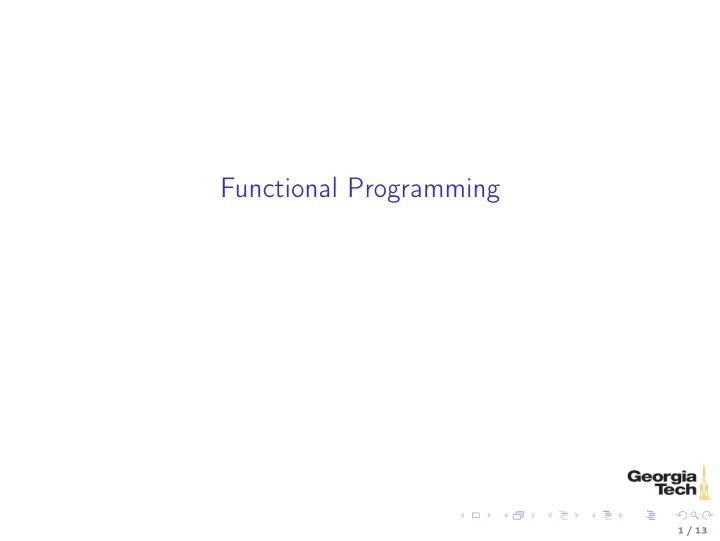

Functional Programming 1 / 13
Functional Features in Python Functions are first class, meaning they can be ◮ stored in variables and data structures ◮ passed as arguments to functions ◮ returned from functions 2 / 13
Higher-Order Functions A higher order function is a function that takes another function as a parameter or returns a function as a value. We’ve already used one: >>> help ( sorted ) ... sorted (iterable, key=None, reverse=False) Return a new list containing all items from the iterable in ascending order. A custom key function can be supplied to customise the sort order, and the reverse flag can be set to request the result in descending order. The second parameter, key , is a function. In general, a sort key is the part of an object on which comparisons are made in a sorting algorithm. 3 / 13
Sorting without a key Say we have a list of tuples, (name, gpa, major): >>> import pprint as pp >>> studs = [("Stan", 2.5, "ISyE"), ("Kyle", 2.2, "CS"), ... ("Cartman", 2.4, "CmpE"), ("Kenny", 4.0, "ME")] The default sort order is simply elementwise by the default order for each type in the tuple: >>> pp.pprint( sorted (studs)) [(’Cartman’, 2.4, ’CmpE’), (’Kenny’, 4.0, ’ME’), (’Kyle’, 2.2, ’CS’), (’Stan’, 2.5, ’ISyE’)] Answer for yourself: what if two students had the same name? 4 / 13
Sorting with a key If we want a different sort order, we can define a function that extracts the part of each tuple by which we want to sort. >>> def by_gpa(stud): ... return stud[1] ... >>> pp.pprint( sorted (studs, key=by_gpa)) [(’Kyle’, 2.2, ’CS’), (’Cartman’, 2.4, ’CmpE’), (’Stan’, 2.5, ’ISyE’), (’Kenny’, 4.0, ’ME’)] sorted is a higher-order function because it takes a function as an argument. 5 / 13
Lambda Functions The by_gpa function is pretty simple. Instead of defining a named function, we can define it inline with an anonymous function, a.k.a., a lambda function: >>> pp.pprint( sorted (studs, key= lambda t: t[1])) [(’Kyle’, 2.2, ’CS’), (’Cartman’, 2.4, ’CmpE’), (’Stan’, 2.5, ’ISyE’), (’Kenny’, 4.0, ’ME’)] The general form is lambda <parameter_list>: <expression> The body of a lambda function is limited to a single expression, which is implicitly returned. 6 / 13
map Common task: build a sequence out of transformations of elements of an existing sequence. Here’s the imperative approach: >>> houses = ["Stark", "Lannister", "Targaryen"] >>> shout = [] >>> for house in houses: ... shout.append(house.upper()) ... >>> shout [’STARK’, ’LANNISTER’, ’TARGARYEN’] Heres’ the functional approach: >>> list ( map ( lambda house: house.upper(), houses)) [’STARK’, ’LANNISTER’, ’TARGARYEN’] Note that map returns an iterator, so we pass it to the list constructor. 7 / 13
filter >>> nums = [0,1,2,3,4,5,6,7,8,9] >>> filter ( lambda x: x % 2 == 0, nums) < filter object at 0x1013e87f0> >>> list ( filter ( lambda x: x % 2 == 0, nums)) [0, 2, 4, 6, 8] 8 / 13
List Comprehensions A list comprehension iterates over a (optionally filtered) sequence, applies an operation to each element, and collects the results of these operations in a new list, just like map . >>> grades = [100, 90, 0, 80] >>> [x for x in grades] [100, 90, 0, 80] >>> [x + 10 for x in grades] [110, 100, 10, 90] We can also filter in a comprehension: >>> [x + 50 for x in grades if x < 50] [50] Comprehensions are more Pythonic than using map and filter directly. 9 / 13
Dictionary Comprehensions First, zip: words = ["Winter is coming", "Hear me roar", "Fire and blood"] >>> list ( zip (houses, words)) [(’Stark’, ’Winter is coming’), (’Lannister’, ’Hear me roar’), (’Targaryen’, ’Fire and blood’)] Dictionary comprehension using tuple unpacking: >>> house2words = {house: words for house, words in zip (houses, words)} >>> house2words {’Lannister’: ’Hear me roar’, ’Stark’: ’Winter is coming’, ’Targaryen’: ’Fire and blood’} Of course, we could just use the dict constructor on the zip object. >>> dict ( zip (houses, words)) {’Lannister’: ’Hear me roar’, ’Stark’: ’Winter is coming’, ’Targaryen’: ’Fire and blood’} 10 / 13
reduce >>> import functools >>> functools. reduce ( lambda x, y: x + y, [0,1,2,3,4,5,6,7,8,9]) 45 i = 1 i = n ( n + 1 ) Confirm this using the standard sum Σ n 2 Here’s factorial: >>> functools. reduce ( lambda x, y: x * y, [1,2,3,4,5]) 120 >>> functools. reduce ( lambda x, y: x * y, range (1,6)) 120 11 / 13
Generator Functions You won’t be tested on generator functions, but they’re too cool not to show you! def class_dates(first, last, class_days): """Generate dates from first to last whose weekdays are in class_days >>> import datetime >>> begin = datetime.date(2016, 8, 22) >>> end = datetime.date(2016, 8, 25) >>> list(class_dates(begin, end, "TR")) [datetime.date(2016, 8, 23), datetime.date(2016, 8, 25)] """ day = first # e.g., "MWF" => [0, 2, 4] class_day_ints = [i for i, letter in enumerate ("MTWRFSU") if letter in class_days] while day <= last: if day.weekday() in class_day_ints: yield day day += dt.timedelta(days=1) 12 / 13
Exercise Write comprehension expressions that build the data structures in the Grades exercise. 13 / 13
Recommend
More recommend